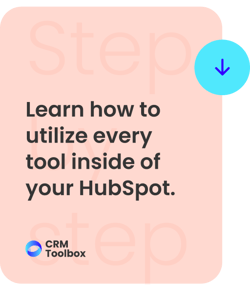Subscribe to ur Blog

Choosing a HubSpot Integration Partner: Proposal Red Flags
Ranya Barakat
Understanding the Decision-Making Stage
Finding a partner who understands your unique challenges and can offer a tailored solution.
The first glimpse of this compatibility often comes through their proposal.
Imagine the proposal as a roadmap, a well-crafted document that reveals which partners genuinely understand your business needs, current state, and desired future state.
It should outline a custom integration plan connecting HubSpot, a leading CRM platform, with your existing tech stack, such as your ERP system, financial system, etc.
This integration is crucial for streamlining your business processes and improving data management.
You're on the right path if the proposal resonates with your specific challenges and objectives. If not, it's a clear sign to look elsewhere.
The Importance of a Well-Structured Proposal
Reviewing a proposal as a window into a partner's approach and expertise. The details they provide help you gauge their understanding of your specific challenges and their capability to tackle them.
Spotting gaps or inconsistencies is a red flag that the partner might need to be the right fit or that potential problems could arise during the integration process.
On the other hand, a well-structured proposal indicates thorough planning and instills confidence that the partner can deliver the integration you need.
The Anatomy of a Perfect Proposal
1. The Executive Summary
Picture the executive summary as a movie trailer. It should provide a concise overview demonstrating the partner's understanding of your needs and offering a clear snapshot of the proposed solution. This section will set the tone for the rest of the proposal and ensure alignment.
2. Background and Context
This section should thoroughly describe your business's current state, challenges, and how the integration will address them. A partner who can articulate these challenges shows that they grasp your unique business context and can deliver a viable solution.
3. Objectives and Scope
Consider this the plot of your story. A well-defined scope and clear objectives ensure everyone is on the same page about goals, data flows, and which departments the integration will affect. This keeps everything transparent and prevents scope creep down the road.
4. Solution Architecture
This part is like the blueprint for building a house. It includes detailed diagrams and explanations of the technical approach and how the systems will interact.

This section demonstrates the partner's competence and assures you they have planned for scalability, security, and smooth data flow.
5. User Journey Flow
Visualize this as the storyboard for your integration project. A well-illustrated user journey flow diagram shows how users and systems will interact, for example, by mapping out touchpoints between the ERP and HubSpot. This diagram will help you visualize how the integration will streamline workflows, improve data accessibility, and simplify customer relationship management.

With a clear user journey diagram, you can avoid mismatched expectations, gaps in the process, and poor user adoption. That's why it's essential to include this in every proposal.
6. User Stories
User stories are like the individual scenes in your movie, capturing specific requirements from the perspective of different end-users. They help you understand how the integration addresses their needs and enhances their daily workflows.

Including user stories ensures clarity and alignment, prioritizes features based on user needs, and centers the design around real-world use cases to avoid overlooked requirements, scope creep, and poor adoption.
7. Entity-Relationship Diagram (ERD)
An ERD is like a detailed map showing the relationships between data entities across HubSpot and the ERP system. It defines how data will be structured, stored, and shared, clearly visualizing data relationships.

An ERD simplifies complex information, improves understanding, enhances communication, identifies potential issues, and supports database design.
8. Implementation Plan
Think of the implementation plan as your project's itinerary. A comprehensive timeline with milestones and deliverables, including User Acceptance Testing (UAT), gives you confidence that the project will stay on track and finish on time. It outlines clear milestones, assigns responsibilities, and ensures efficient resource allocation.
9. Budget and Costs
This section is the project's financial blueprint. A transparent breakdown of all costs, including development, licenses, and resources, helps you avoid hidden expenses and aligns expectations with your available budget. It ensures the project's feasibility, secures funding approval, and aids in budgeting and risk management.
10. Risk Management
Risk management is like a safety net. Identifying potential risks, such as data security breaches or system downtime, and outlining mitigation strategies shows our proactive planning that reduces issues during integration. We assess the impact and likelihood of each risk, develop mitigation strategies, and support decision-making, ensuring the project proceeds smoothly despite uncertainties.
11. Training and Support
A detailed plan for training your team and offering ongoing support post-implementation ensures you're prepared to use and maintain the solution effectively. It facilitates successful adoption, enhances efficiency and productivity, and reduces resistance to change.
12. Compliance and Security
This section is your fortress. Knowing the partner has a straightforward approach to data security and compliance with industry regulations protects your sensitive business data and keeps you compliant, preventing costly violations.
Recognizing Red Flags
Certain red flags indicate that a partner might not be the right fit when reviewing a proposal. If they need a clearer understanding of your business challenges, have an unclear scope or ambiguous objectives, or present vague timelines and deliverables, it's time to reconsider. Also, a lack of transparency in the budget or limited post-implementation support can be significant warning signs.
Receiving the Proposal
We go beyond the usual call or document when you request our proposal. You'll receive the complete proposal ahead of time, accompanied by a personal video from me explaining everything in detail. This comprehensive approach gives your team ample time to review, brainstorm, and reflect on the integration plan, underlining the importance we place on your project.
When it's time for our call, we're ready to discuss the proposal further, answer any questions, and provide a solid, strategic solution tailored to your needs. This preparation means we spend time together refining the integration rather than reiterating fluff. Ultimately, we assure you that we understand your requirements and can deliver a seamless HubSpot-ERP integration.
Conclusion: Finding the Right Partner
The importance of a well-structured proposal cannot be overstated. When choosing a partner, compare their proposals against this outline to ensure they align with your expectations.
The right partner will understand your unique needs and offer a comprehensive, transparent, and tailored proposal that shows how they'll deliver a successful integration solution.
If you're ready to explore how a tailored integration can work for your business, I suggest booking a consultation or discovery call with my team. We'll discuss your specific needs and craft the best solution. To see how we've helped others with successful integrations, check out these resources and case studies that showcase our work.
Related Reads
Master HubSpot tools & unleash a world of endless possibilities!
Unlock Your HubSpot Powerhouse: Contact Us to Transform Your Digital Journey!

Ranya Barakat
Ranya is a serial entrepreneur with over 11 years of experience working on the HubSpot CRM. She is a tech geek with a passion for solving problems for customers. She loves pushing her sleeves up , and getting s*** done. When she is not running her Global services team, you can find her upside down on her yoga mat.
Subscribe to our blog
The best information about inbound marketing, sales, guides and migrations.



